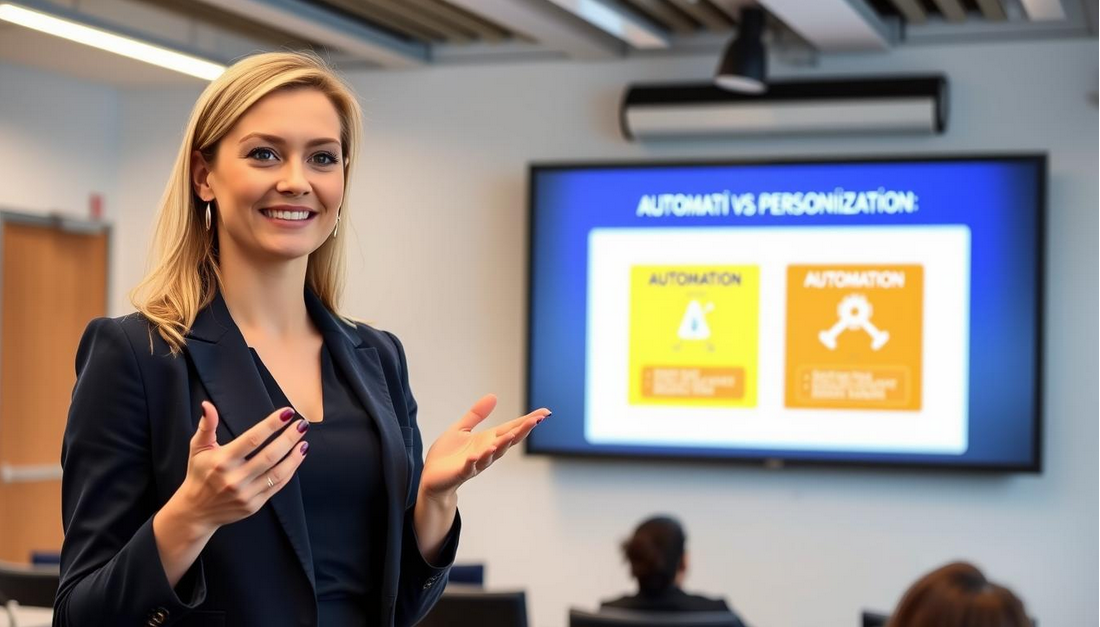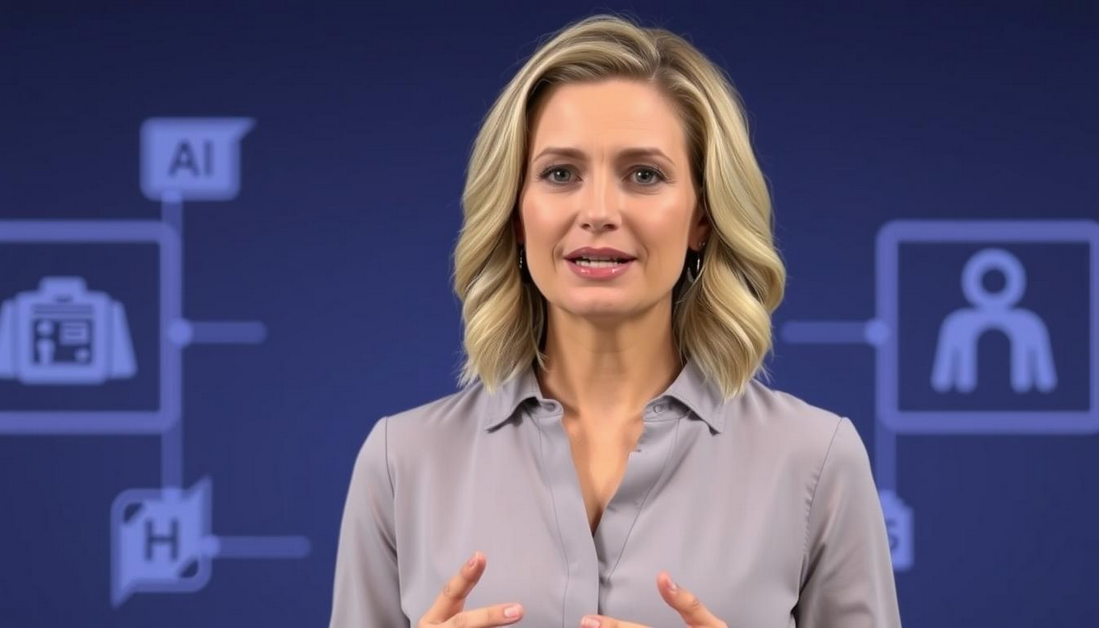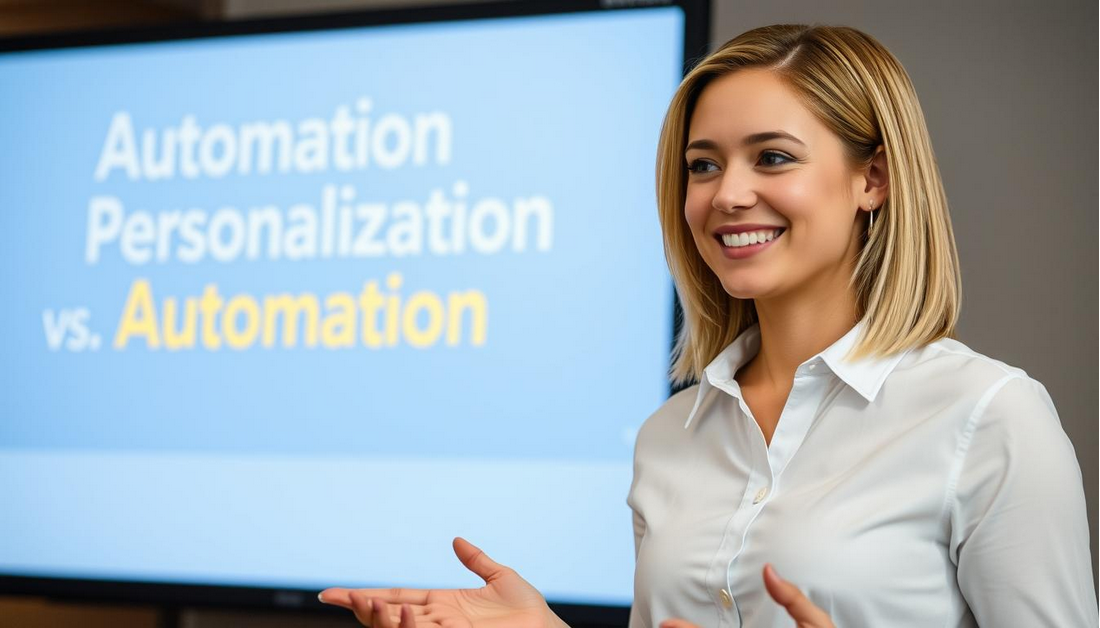India customers to view on amazon.in
Automation vs. Personalization: What Customers Really Want
In today’s digital landscape, businesses are constantly torn between automation and personalization to enhance customer experience. While automation streamlines processes, personalization tailors interactions to individual needs.
- The Evolving Landscape of Customer Experience
- Understanding Automation vs. Personalization: What Customers Really Want
- Defining Automation in the Customer Journey
- The Art and Science of Personalization
- Breaking Down the False Dichotomy
- The Psychology Behind Customer Preferences
- The Benefits of Automation in Customer Experience
- Speed and Efficiency Advantages
- Cost Reduction and Scalability
- Consistency Across Customer Touchpoints
- The Power of Personalization in Building Customer Loyalty
- Creating Emotional Connections with Customers
- Tailoring Experiences to Individual Needs
- The Impact on Customer Lifetime Value
- Data Privacy Concerns in the Personalization Era
- The Privacy Paradox: Personalization vs. Protection
- Building Trust Through Transparent Data Practices
- Finding the Sweet Spot: When to Automate vs. When to Personalize
- AI-Driven Personalization: The Best of Both Worlds
- Case Studies: Successful Balance of Automation and Personalization
- Implementation Strategies for Businesses
- Data Collection and Management Foundations
- Technology Integration Considerations
- Training Teams for the Hybrid Approach
- Conclusion: Creating Customer-Centric Experiences in the Digital Age
- FAQ
- What is the main difference between automation and personalization in customer experience?
- How does AI-driven personalization work?
- What are the benefits of automation in customer experience?
- How can businesses balance automation and personalization?
- What is the role of data privacy in personalization?
- Can you provide examples of successful automation and personalization strategies?
- How can businesses implement a hybrid approach that combines automation and personalization?
- What are the key considerations for businesses when implementing personalization technologies?
- How does personalization impact customer lifetime value?

So, what do customers really want? Research suggests that a customer-centric approach is key. By understanding customer preferences, businesses can strike a balance between efficient automation and meaningful personalization, ultimately improving the online user experience.
Key Takeaways
- Customers value a personalized experience.
- Automation can enhance efficiency.
- A customer-centric approach is crucial.
- Balancing automation and personalization is key.
- Understanding customer preferences is vital.
The Evolving Landscape of Customer Experience
Digital transformation is revolutionizing customer experience, altering consumer expectations forever. The way businesses interact with customers has changed dramatically, driven by technological advancements and shifting consumer behaviors.
Digital Transformation’s Impact on Consumer Expectations
The digital age has significantly impacted how consumers expect to interact with businesses. With the rise of digital technologies, consumers now anticipate seamless, personalized experiences across all touchpoints.
Key Statistics on Customer Experience Trends
Recent studies show that 80% of consumers consider the experience a company provides as much important as its products or services. Moreover, 73% of customers use multiple channels to engage with businesses, highlighting the need for an omnichannel approach.
The Pandemic’s Acceleration Effect
The COVID-19 pandemic has accelerated digital transformation, with businesses rapidly adapting to new customer behaviors. This shift has led to an increased demand for digital-first customer experiences, pushing companies to innovate and adapt quickly.
The Modern Customer’s Paradoxical Demands
Today’s customers present businesses with a paradox: they desire both convenience and connection. While speed and efficiency are crucial, they also value high-quality interactions that foster loyalty.
Convenience vs. Connection
Consumers seek convenience through automated processes, yet they also crave human connection. Businesses must strike a balance between these seemingly opposing demands to meet customer expectations effectively.
Speed vs. Quality Interactions
The need for speed is paramount, with customers expecting quick responses and resolutions. However, this must be balanced with the quality of interactions, ensuring that efficiency doesn’t compromise the personal touch.

Understanding Automation vs. Personalization: What Customers Really Want
With technological advancements, businesses are now faced with the challenge of determining how to effectively blend automation with personalization to meet customer expectations.
Defining Automation in the Customer Journey
Automation in the customer journey refers to the use of technology to perform tasks without human intervention. This can significantly enhance efficiency and reduce response times.
Types of Customer-Facing Automation
Customer-facing automation includes chatbots, automated email responses, and interactive voice response systems. These tools directly interact with customers, providing immediate assistance.
Behind-the-Scenes Automation
Behind-the-scenes automation involves processes like data processing, inventory management, and order fulfillment. These automated processes ensure that customer requests are handled efficiently.
The Art and Science of Personalization
Personalization involves tailoring the customer experience to individual preferences and behaviors. It requires a deep understanding of customer data to deliver relevant content and offers.
Levels of Personalization Maturity
Personalization maturity can range from basic (using customer names in emails) to advanced (using AI to predict customer needs). Businesses must assess their capabilities to determine the level of personalization they can effectively implement.
Personalization vs. Customization
While personalization is about tailoring experiences based on customer data, customization allows customers to make choices about their experience. Both are crucial for meeting customer expectations.
Breaking Down the False Dichotomy
The choice between automation and personalization is not binary. Businesses can leverage both to create a seamless customer experience. For instance, automation can handle routine inquiries, freeing up human agents to focus on complex, personalized interactions.
| Aspect | Automation | Personalization |
|---|---|---|
| Purpose | Efficiency and Speed | Relevance and Engagement |
| Customer Impact | Quick Responses | Tailored Experiences |
| Business Benefit | Cost Reduction | Increased Loyalty |

The Psychology Behind Customer Preferences
Understanding customer psychology is crucial for businesses aiming to strike the right balance between automation and personalization. Customer preferences are influenced by a complex array of psychological factors, including the need for recognition, the desire for efficiency, and the appreciation of personal touch.
The Human Need for Recognition and Connection
Customers have an inherent need for recognition and connection, which significantly influences their satisfaction and loyalty. This need is rooted in psychological principles that drive human behavior.
Psychological Studies on Customer Satisfaction
Research has shown that customer satisfaction is closely linked to the feeling of being recognized and understood. Studies in consumer psychology highlight the importance of emotional connections in customer experiences.
The Recognition Factor in Loyalty
The recognition factor plays a crucial role in fostering customer loyalty. When customers feel acknowledged and valued, they are more likely to remain loyal to a brand.
When Efficiency Trumps the Personal Touch
While personalization is important, there are instances where customers prefer efficiency over a personal touch. This preference is often context-dependent and influenced by the nature of the interaction.

Task-Oriented vs. Experience-Oriented Interactions
In task-oriented interactions, customers tend to prioritize efficiency and speed. In contrast, experience-oriented interactions benefit from a more personalized approach.
Context-Dependent Preferences
Customer preferences can vary significantly depending on the context of the interaction. Understanding these contextual nuances is key to delivering the right balance between automation and personalization.
| Interaction Type | Customer Preference | Recommended Approach |
|---|---|---|
| Task-Oriented | Efficiency | Automation |
| Experience-Oriented | Personal Touch | Personalization |
The Benefits of Automation in Customer Experience
In the digital age, automation stands out as a key driver of enhanced customer experiences. By integrating automation into their customer service strategies, businesses can reap numerous benefits that directly impact their bottom line and customer satisfaction levels.

Speed and Efficiency Advantages
Automation significantly enhances the speed and efficiency of customer service operations. This is achieved through:
- Automated response systems that handle initial customer inquiries.
- Streamlined processes that reduce the time taken to resolve customer issues.
Response Time Improvements
Automated systems can respond to customer inquiries instantly, reducing wait times and improving overall customer satisfaction. This immediacy is crucial in today’s fast-paced digital landscape.
24/7 Availability Benefits
Automation enables businesses to provide round-the-clock customer service without the need for human intervention. This ensures that customers can get assistance at any time, enhancing their overall experience.
Cost Reduction and Scalability
Automation not only improves customer experience but also offers significant cost savings and scalability for businesses. By automating routine tasks, companies can:
- Reduce labor costs associated with manual processing.
- Scale their customer service operations more efficiently.
Resource Optimization Examples
By automating routine inquiries and tasks, businesses can optimize their human resources for more complex and value-added tasks. This strategic allocation of resources leads to improved operational efficiency.
Handling Volume Fluctuations
Automated systems can handle sudden spikes in customer inquiries without a decrease in service quality. This scalability is particularly beneficial during peak periods or promotional events.
Consistency Across Customer Touchpoints
Automation helps in maintaining consistency across various customer touchpoints. This is achieved by:
- Standardizing responses to frequently asked questions.
- Ensuring that all customers receive a uniform brand experience.
Reducing Human Error
Automated systems minimize the likelihood of human error, ensuring that customers receive accurate and reliable information. This accuracy is crucial for building trust and loyalty.
Brand Voice Consistency
Automation enables businesses to maintain a consistent brand voice across all customer interactions. This consistency reinforces the brand identity and enhances customer recognition.
The Power of Personalization in Building Customer Loyalty
Building customer loyalty in the digital age requires a deep understanding of personalization and its impact on consumer behavior. As businesses strive to create meaningful connections with their customers, personalization has emerged as a critical strategy.

Creating Emotional Connections with Customers
Personalization enables businesses to create emotional connections with their customers by tailoring experiences to individual needs and preferences. This connection is crucial for building loyalty.
The Memorability Factor
When customers receive personalized messages or offers, it creates a memorable experience, making them more likely to remember the brand.
Trust Development Through Recognition
Personalization helps in developing trust through recognition. When customers feel recognized and understood, they are more likely to trust the brand.
Tailoring Experiences to Individual Needs
Tailoring experiences to individual needs is a key aspect of personalization. This can be achieved through various methods, including preference-based and behavior-based personalization.
Preference-Based Personalization
Preference-based personalization involves tailoring experiences based on customer preferences, such as product recommendations.
Behavior-Based Personalization
Behavior-based personalization focuses on customer behavior, such as purchase history and browsing behavior, to offer relevant experiences.
The Impact on Customer Lifetime Value
Personalization has a significant impact on customer lifetime value by improving retention rates and creating cross-selling and upselling opportunities.
Retention Rate Improvements
By creating personalized experiences, businesses can improve customer retention rates, leading to increased loyalty.
Cross-Selling and Upselling Opportunities
Personalization also enables businesses to identify cross-selling and upselling opportunities, further enhancing customer lifetime value.
In conclusion, personalization is a powerful tool for building customer loyalty. By creating emotional connections, tailoring experiences to individual needs, and impacting customer lifetime value, businesses can foster a loyal customer base.
Data Privacy Concerns in the Personalization Era
In the age of personalization, companies are under pressure to deliver customized experiences while ensuring the privacy and security of customer data. This delicate balance is at the heart of the privacy paradox.
The Privacy Paradox: Personalization vs. Protection
The desire for personalized services often conflicts with the need to protect sensitive information. Consumers want tailored experiences, but they also worry about how their data is being used.
Consumer Attitudes Toward Data Sharing
Studies show that consumers are increasingly cautious about sharing their personal data. Transparency and control are key factors in building trust.
Regulatory Landscape Overview
Regulations like GDPR and CCPA have been implemented to protect consumer data. Companies must comply with these regulations to avoid hefty fines.
Building Trust Through Transparent Data Practices
To build trust, businesses must adopt transparent data practices. This includes being clear about data collection and usage.
Consent-Based Personalization Strategies
Obtaining explicit consent from consumers is crucial. This approach not only complies with regulations but also fosters trust.
Privacy-Preserving Personalization Technologies
Technologies that enable personalization while preserving privacy are gaining traction. These include methods like differential privacy and federated learning.

By embracing transparent data practices and leveraging privacy-preserving technologies, businesses can navigate the complexities of data privacy in the personalization era.
Finding the Sweet Spot: When to Automate vs. When to Personalize
Finding the sweet spot between automation and personalization is essential for delivering customer-centric experiences that drive loyalty and growth. To achieve this balance, businesses must understand their customers’ journeys and identify the touchpoints that require a human touch versus those that can be efficiently automated.
Customer Journey Mapping for Balanced Experiences
Customer journey mapping is a critical tool for visualizing the customer’s experience across multiple touchpoints and over time. By mapping out these journeys, businesses can identify areas where automation can enhance efficiency and areas where personalization can build emotional connections.
High-Touch vs. Low-Touch Touchpoints
High-touch touchpoints are those that require a personal, human interaction, such as complex customer service issues or high-value sales negotiations. In contrast, low-touch touchpoints, like routine inquiries or transactional processes, can often be automated to improve efficiency and reduce costs.
Emotion-Critical Moments
Emotion-critical moments are those instances where the customer’s emotional state is significantly impacted by the interaction, such as during onboarding or when resolving a complaint. Personalization is crucial in these moments to build trust and loyalty.

Decision Framework for Business Leaders
A decision framework can help business leaders navigate the complex decisions involved in balancing automation and personalization. This framework should consider factors such as ROI and customer segment analysis to make informed decisions.
ROI Considerations
When evaluating the balance between automation and personalization, ROI is a critical consideration. Businesses must weigh the costs of implementing personalized experiences against the potential returns in terms of customer loyalty and lifetime value.
Customer Segment Analysis
Different customer segments may have varying preferences for automation versus personalization. Conducting customer segment analysis can help businesses tailor their approach to meet the unique needs of each segment, thereby maximizing the effectiveness of their customer experience strategies.
By applying this decision framework and understanding the nuances of customer journey mapping, businesses can find the sweet spot that balances the efficiency of automation with the emotional connection of personalization, ultimately driving customer satisfaction and loyalty.
AI-Driven Personalization: The Best of Both Worlds
By leveraging AI technologies, companies can now achieve a balance between automation and personalization, offering customers a more tailored experience without sacrificing efficiency.
How AI Technologies Enable Mass Personalization
AI is at the forefront of enabling mass personalization through advanced data analysis and machine learning algorithms. This allows businesses to understand customer behavior and preferences on a large scale.
Machine Learning for Preference Prediction
Machine learning plays a crucial role in predicting customer preferences by analyzing historical data and identifying patterns. This enables businesses to anticipate customer needs and tailor their offerings accordingly.
Natural Language Processing in Customer Interactions
Natural Language Processing (NLP) is another AI technology that enhances customer interactions by enabling more natural and intuitive communication between humans and machines. NLP can be used in chatbots and virtual assistants to provide more personalized support.
Real-Time Personalization Technologies
Real-time personalization is made possible through AI-driven technologies that can analyze customer data and behavior as it happens. This allows for immediate adjustments to be made to the customer experience.
Dynamic Content Optimization
Dynamic content optimization involves using real-time data to adjust the content presented to customers, ensuring that it is always relevant and engaging. This can significantly enhance the customer experience and drive conversions.
Behavioral Triggers and Automation
Behavioral triggers are used to automate specific actions based on customer behavior, such as sending a follow-up email after a customer abandons their shopping cart. This ensures that customers receive timely and relevant communications.

Case Studies: Successful Balance of Automation and Personalization
In today’s competitive market, companies are finding innovative ways to strike the right balance between automated efficiency and personalized customer interactions. This balance is crucial for enhancing customer experiences and driving business success.
E-commerce Success Stories
E-commerce businesses have been at the forefront of adopting automation and personalization technologies. Two notable examples are Amazon and Sephora.
Amazon’s Recommendation Engine
Amazon’s recommendation engine is a prime example of successful automation. By analyzing customer behavior and purchase history, Amazon provides personalized product recommendations, enhancing the shopping experience and increasing sales.
Sephora’s Virtual Assistant and Human Expert Combination
Sephora has effectively combined automation with personalization by offering a virtual assistant that helps customers find products, while also providing access to human beauty experts for personalized advice. This hybrid approach has improved customer satisfaction and loyalty.
Service Industry Transformations
The service industry, including banking and healthcare, has also seen significant transformations through the balance of automation and personalization.
Banking Industry Innovations
Banks are using automation to streamline processes such as account opening and customer support, while personalization is used to offer tailored financial products and services based on customer data.
Healthcare’s Personalized Patient Journeys
In healthcare, automation is being used to manage routine administrative tasks, while personalization is enhancing patient care through tailored treatment plans and patient engagement strategies.
These case studies demonstrate that a successful balance between automation and personalization can lead to improved customer satisfaction, increased efficiency, and business growth.
Implementation Strategies for Businesses
Implementing a balanced approach to automation and personalization requires careful planning and strategic decision-making. Businesses must consider several key factors to effectively integrate these elements and enhance customer experience.
Data Collection and Management Foundations
A robust data collection and management system is crucial for balancing automation and personalization. This involves:
- Utilizing Customer Data Platforms (CDPs) to unify customer data
- Ensuring data quality and integration across various touchpoints
Customer Data Platform Essentials
A Customer Data Platform (CDP) is essential for creating a single customer view, enabling businesses to deliver personalized experiences. It aggregates data from various sources, providing a comprehensive understanding of customer behavior.
Data Quality and Integration
High-quality, integrated data is vital for making informed decisions about automation and personalization. Businesses must focus on data accuracy, completeness, and consistency to drive effective customer engagement strategies.
Technology Integration Considerations
Selecting the right technology and ensuring seamless integration with existing systems is critical. Key considerations include:
- Choosing tools that support both automation and personalization
- Ensuring compatibility with legacy systems to avoid disruptions
Selecting the Right Tools
Businesses must evaluate various tools and platforms to determine which best support their customer experience goals. This involves assessing features, scalability, and integration capabilities.
Integration with Legacy Systems
Effective integration with existing legacy systems is crucial to avoid operational disruptions. Businesses should prioritize technologies that offer flexible integration options.
Training Teams for the Hybrid Approach
To successfully implement a balanced strategy, teams must be equipped with the necessary skills. This includes:
- Developing human-AI collaboration skills to leverage technology effectively
- Fostering empathy in automated environments to maintain a personal touch
Human-AI Collaboration Skills
Training teams to work alongside AI systems is essential for maximizing the benefits of automation while maintaining personalized customer interactions.
Empathy in Automated Environments
Even in automated settings, empathy remains a crucial element of customer service. Teams should be trained to understand and respond to customer emotions effectively.
Conclusion: Creating Customer-Centric Experiences in the Digital Age
As we navigate the complexities of customer experience in today’s digital landscape, it becomes clear that a one-size-fits-all approach no longer suffices. Businesses must strike a balance between automation and personalization to meet the evolving expectations of their customers.
The key to success lies in understanding when to leverage the efficiency of automation and when to inject a personal touch. By doing so, companies can create customer-centric experiences that not only drive loyalty but also foster meaningful connections in the digital age.
Ultimately, the goal is to craft experiences that feel both personalized and seamless. As businesses continue to navigate this delicate balance, they must remain committed to using data and technology to inform their strategies, ensuring that their approach to customer experience remains both innovative and customer-focused.
FAQ
What is the main difference between automation and personalization in customer experience?
Automation refers to the use of technology to perform tasks without human intervention, while personalization involves tailoring experiences to individual customer needs and preferences.
How does AI-driven personalization work?
AI-driven personalization uses machine learning algorithms and natural language processing to analyze customer data and behavior, enabling businesses to deliver tailored experiences in real-time.
What are the benefits of automation in customer experience?
Automation improves response times, availability, and resource optimization, while also reducing human error and ensuring consistency across customer touchpoints.
How can businesses balance automation and personalization?
Businesses can achieve a balance by mapping the customer journey, identifying high-touch and low-touch touchpoints, and using a decision framework that considers ROI and customer segment analysis.
What is the role of data privacy in personalization?
Data privacy is crucial in personalization, as customers expect businesses to protect their data while delivering tailored experiences. Businesses must adopt transparent data practices and comply with regulatory requirements.
Can you provide examples of successful automation and personalization strategies?
Companies like Amazon and Sephora have successfully implemented automation and personalization strategies, using technologies like recommendation engines and virtual assistants to enhance customer experiences.
How can businesses implement a hybrid approach that combines automation and personalization?
Businesses can start by establishing a solid data collection and management foundation, integrating the right technologies, and training teams to work effectively in a hybrid environment that balances human empathy with AI-driven automation.
What are the key considerations for businesses when implementing personalization technologies?
Businesses should consider factors like customer data platform essentials, data quality and integration, and the selection of the right tools to support their personalization strategies.
How does personalization impact customer lifetime value?
Personalization can significantly improve customer lifetime value by increasing retention rates, driving cross-selling and upselling opportunities, and fostering emotional connections with customers.







